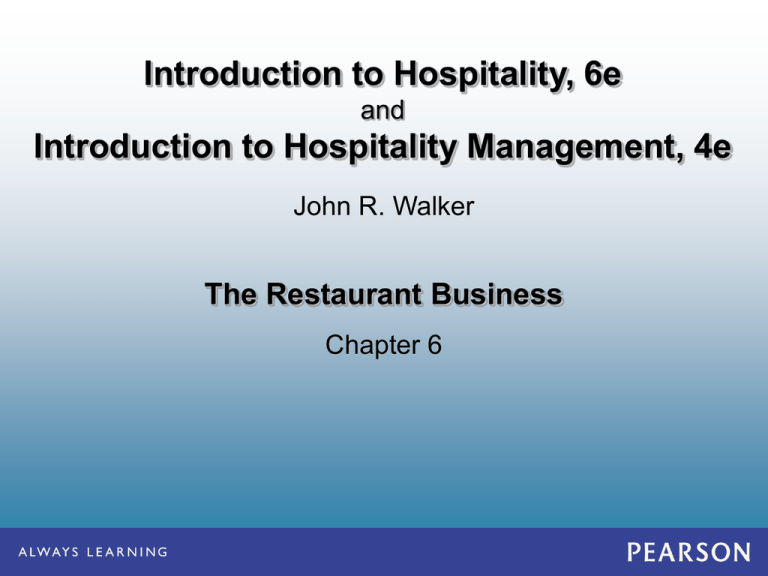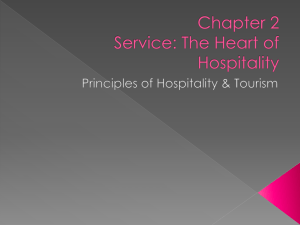
Introduction to Hospitality, 6e
and
Introduction to Hospitality Management, 4e
John R. Walker
The Restaurant Business
Chapter 6
The Restaurant Business
• A place to relax and enjoy the company of family
and friends and to restore energy
• As a society we spend about 47.5% of our food
dollars away from home
• The word restaurant comes from the French
word meaning restore
• Multi-billion dollar business employing 12.8
million people
Introduction to Hospitality, 6e and Introduction to
Hospitality Management, 4e - Walker
© 2013 by Pearson Higher Education, Inc
Upper Saddle River, New Jersey 07458 • All Rights Reserved
Classical Cuisine
• North America gained most of its culinary legacy
from France through 2 main events:
– French Revolution in 1793—caused the best French
chefs of the day to lose their employment because
their bosses lost their heads! Many chefs came to
North America as a result.
– In 1784, Thomas Jefferson spent five years as envoy
to France, and brought a French chef to the White
House when he became president.
• Mari-Antoine Carême (1784–1833) is credited
as the founder of classical cuisine
• August Escoffier (1846–1935) is also noted for
his many contributions to cuisine
Introduction to Hospitality, 6e and Introduction to
Hospitality Management, 4e - Walker
© 2013 by Pearson Higher Education, Inc
Upper Saddle River, New Jersey 07458 • All Rights Reserved
Classical Cuisine
• There are five mother sauces: Béchamel,
Velouté, Espagnole, tomato, and hollandaise
• Nouvelle cuisine is a lighter cuisine and is
based on simpler preparations—with the aid of
processors, blenders, and juicers—using more
natural flavors and ingredients
Introduction to Hospitality, 6e and Introduction to
Hospitality Management, 4e - Walker
© 2013 by Pearson Higher Education, Inc
Upper Saddle River, New Jersey 07458 • All Rights Reserved
Food Trends and Practices
• Chefs will need:
– A strong culinary foundation.
– Multicultural cooking skills and strong
employability traits.
– Additional management skills.
Introduction to Hospitality, 6e and Introduction to
Hospitality Management, 4e - Walker
© 2013 by Pearson Higher Education, Inc
Upper Saddle River, New Jersey 07458 • All Rights Reserved
Culinary Practices
• To be a good cook, one must understand the
basic techniques and principles of cooking.
There are six skill areas that are important to
becoming a successful chef: cooking, menu
development, sanitation/safety, accounting,
computer training, food trends and practices for
the new millennium.
• One of the most important things to learn about
the industry is that you can’t do it alone; it’s a
team effort.
Introduction to Hospitality, 6e and Introduction to
Hospitality Management, 4e - Walker
© 2013 by Pearson Higher Education, Inc
Upper Saddle River, New Jersey 07458 • All Rights Reserved
Developing a Restaurant
• The restaurant:
– Operating philosophy represents the way the
company does business.
– Market is composed of those guests who will
patronize the restaurant.
– Concepts are created with guests in mind and
should fit a definite market.
– Location should also appeal to the target market.
– Ambiance, or the atmosphere, that a restaurant
creates has both immediate conscious and
unconscious effects on guests.
Introduction to Hospitality, 6e and Introduction to
Hospitality Management, 4e - Walker
© 2013 by Pearson Higher Education, Inc
Upper Saddle River, New Jersey 07458 • All Rights Reserved
Operating Philosophy, Mission,
Goals, and Objectives
• The philosophy of the owner is the heart of the
enterprise.
• This represents the way the company does
business.
• It is an expression of the ethics, morals, and
values by which the company operates.
Introduction to Hospitality, 6e and Introduction to
Hospitality Management, 4e - Walker
© 2013 by Pearson Higher Education, Inc
Upper Saddle River, New Jersey 07458 • All Rights Reserved
Restaurant Market
• The market is composed of those guests who
will patronize the restaurant.
• A niche is a specific share or slot of a certain
market.
• The catchment area is a given radius or area
where potential customers are—could be a one
or two block radius in a big city or a two or five
mile radius in rural areas.
Introduction to Hospitality, 6e and Introduction to
Hospitality Management, 4e - Walker
© 2013 by Pearson Higher Education, Inc
Upper Saddle River, New Jersey 07458 • All Rights Reserved
Restaurant Concept
• Successful concepts are created with guests in
mind. The concept represents the type of
restaurant and clientele—it is an impression or
an image that appeals to certain markets
(casual, children, formal, family, ethnic, etc.)
• The restaurant business with the right location,
food, atmosphere, and service is going to get a
good market share and make a good return on
investment.
Introduction to Hospitality, 6e and Introduction to
Hospitality Management, 4e - Walker
© 2013 by Pearson Higher Education, Inc
Upper Saddle River, New Jersey 07458 • All Rights Reserved
Restaurant Location
• The concept should fit the location and location
fit the concept. The location should appeal to
the target market.
• Rent/lease costs should be between 5 and 8
percent of sales.
• Some location criteria include; demographics,
average income of catchment area, zoning,
visibility, accessibility, parking, city, suburban,
etc.
Introduction to Hospitality, 6e and Introduction to
Hospitality Management, 4e - Walker
© 2013 by Pearson Higher Education, Inc
Upper Saddle River, New Jersey 07458 • All Rights Reserved
Restaurant Ambiance
• The atmosphere that a restaurant creates has
both immediate conscious and unconscious
effects on guests.
• The immediate conscious effect is how guests
react to the ambiance.
• The subconscious is affected by mood, lighting,
furnishings, and music.
Introduction to Hospitality, 6e and Introduction to
Hospitality Management, 4e - Walker
© 2013 by Pearson Higher Education, Inc
Upper Saddle River, New Jersey 07458 • All Rights Reserved
Sustainable Restaurants
• The average American meal has a shockingly
large carbon footprint, usually travelling 1,500
miles to the plate and emitting large amounts of
CO2.
• Each meal produces 275 pounds of waste a day,
making restaurants the worst aggressors of
greenhouse gas emissions in retail history.
• Utility costs are a big line item for restaurants,
accounting for a median of between 2.3 percent
and 3.6 percent of sales.
Introduction to Hospitality, 6e and Introduction to
Hospitality Management, 4e - Walker
© 2013 by Pearson Higher Education, Inc
Upper Saddle River, New Jersey 07458 • All Rights Reserved
Menu Planning
• The menu may be the most important ingredient in the
restaurant’s success
• There are six main types of menus:
– A la carte menus—items are individually priced
– Table d’hôte menus—a selection of one or more
items for each course at a fixed price
– Du jour menus—lists the items “of the day”
– Tourist menus—used to attract tourists’ attention
– California menus—are so named because in some
California restaurants, guests may order any item on
the menu at any time of the day
– Cyclical menus—repeat themselves
Introduction to Hospitality, 6e and Introduction to
Hospitality Management, 4e - Walker
© 2013 by Pearson Higher Education, Inc
Upper Saddle River, New Jersey 07458 • All Rights Reserved
Menu Planning
• The many considerations in menu planning include:
– Needs and desires of guests
– Capabilities of cooks
– Equipment capacity and layout
– Consistency and availability of menu ingredients
– Price and pricing strategy (cost and profitability)
– Nutritional value
– Accuracy in menu
– Menu analysis (contribution margin)
– Menu design
– Menu engineering
– Chain menus
Introduction to Hospitality, 6e and Introduction to
Hospitality Management, 4e - Walker
© 2013 by Pearson Higher Education, Inc
Upper Saddle River, New Jersey 07458 • All Rights Reserved
Classifications of Restaurants
• There is not a single definition of restaurant
classification. Most experts agree there are two
main categories – independent and chain
restaurants. Other categories include fine dining,
quick service, ethnic, family, dinner house,
occasion, casual, etc.
• Some restaurants may fall into more than one
category. For instance, a restaurant can be both
ethnic and quick service, such as Taco Bell.
Introduction to Hospitality, 6e and Introduction to
Hospitality Management, 4e - Walker
© 2013 by Pearson Higher Education, Inc
Upper Saddle River, New Jersey 07458 • All Rights Reserved
Classifications of Restaurants
• Individual restaurants are typically one or more
owners who are usually involved in the day-today operation of the business.
• Chain restaurants comprise a group of
restaurants, each identical in market, concept,
design, service, food, and name. Part of the
marketing strategy is to remove uncertainty from
the dining experience.
Introduction to Hospitality, 6e and Introduction to
Hospitality Management, 4e - Walker
© 2013 by Pearson Higher Education, Inc
Upper Saddle River, New Jersey 07458 • All Rights Reserved
Fine Dining
• A fine dining restaurant is one where a good
selection of menu items is offered – at least
fifteen or more different entrees cooked to order
and nearly all the food being made on the
premises from scratch or fresh ingredients.
Introduction to Hospitality, 6e and Introduction to
Hospitality Management, 4e - Walker
© 2013 by Pearson Higher Education, Inc
Upper Saddle River, New Jersey 07458 • All Rights Reserved
Celebrity Restaurants
• Celebrities who may or may not have F & B
backgrounds own these operations.
• The operations are designed to be entertaining,
drawing heavily on the notoriety of their owners.
• Celebrity restaurants generally have an extra
zing to them…a winning combination of design,
atmosphere, food, and perhaps the thrill of an
occasional visit by the owner(s).
Introduction to Hospitality, 6e and Introduction to
Hospitality Management, 4e - Walker
© 2013 by Pearson Higher Education, Inc
Upper Saddle River, New Jersey 07458 • All Rights Reserved
Steak Houses
• The steak restaurant is still strong in spite of
recent nutritional concerns. To remain more
competitive, many operations are adding “value
priced items” such as chicken or fish. These
items serve to attract more customers.
• The upscale steak house, like Morton’s of
Chicago, Ruth Chris’s, and Houston’s, continue
to attract the expense account and “occasion”
diners.
Introduction to Hospitality, 6e and Introduction to
Hospitality Management, 4e - Walker
© 2013 by Pearson Higher Education, Inc
Upper Saddle River, New Jersey 07458 • All Rights Reserved
Casual Dining
and Dinner House Restaurants
• The types of restaurants that can be included in
the casual dining restaurants category are:
midscale casual restaurants, family restaurants,
ethnic restaurants, theme, and quickservice/fast-food.
• The trend in dinner house restaurants has been
toward more casual dining. Many dinner house
restaurants have a casual, eclectic décor that
may promote a theme.
Introduction to Hospitality, 6e and Introduction to
Hospitality Management, 4e - Walker
© 2013 by Pearson Higher Education, Inc
Upper Saddle River, New Jersey 07458 • All Rights Reserved
Family Restaurants
• Family restaurants evolved from coffee shop
restaurants. Many are individually or family
operated.
• Most often they offer an informal setting with a
simple menu and service designed to please all
of the family.
• The lines separating the various restaurants and
chains in the family segment are blurring as
operators upscale their concepts.
Introduction to Hospitality, 6e and Introduction to
Hospitality Management, 4e - Walker
© 2013 by Pearson Higher Education, Inc
Upper Saddle River, New Jersey 07458 • All Rights Reserved
Ethnic Restaurants
• The majority of ethnic restaurants are family
owned and operated and sprang up to cater to
tastes of various ethnic groups.
• The fastest growing segment of ethnic
restaurants is Mexican.
Introduction to Hospitality, 6e and Introduction to
Hospitality Management, 4e - Walker
© 2013 by Pearson Higher Education, Inc
Upper Saddle River, New Jersey 07458 • All Rights Reserved
Theme Restaurants
• Many theme restaurants are a combination of a
sophisticated specialty and several other types
of restaurants.
• They generally serve a limited menu but aim to
wow the guest by the total experience.
• People are attracted to theme restaurants
because they offer a total experience and a
social meeting place.
Introduction to Hospitality, 6e and Introduction to
Hospitality Management, 4e - Walker
© 2013 by Pearson Higher Education, Inc
Upper Saddle River, New Jersey 07458 • All Rights Reserved
Quick Service/Fast Food
• This quick-service sector really drives the
industry. Quick-service or fast-food restaurants
offer limited menus.
• In an attempt to raise flat sales figures, more
quick-service restaurant (QSR) chains are using
co-branding at stores and nontraditional
locations, including highway plazas and
shopping centers.
Introduction to Hospitality, 6e and Introduction to
Hospitality Management, 4e - Walker
© 2013 by Pearson Higher Education, Inc
Upper Saddle River, New Jersey 07458 • All Rights Reserved
Hamburger
• The world’s greatest fast food success story is
undoubtedly McDonald’s. McDonald’s story is
amazing because it’s larger than the next three
mega-chains combined – Burger King, KFC, and
Pizza Hut. McDonald’s is now in 117 countries.
• Each of the hamburger restaurant chains has a
unique positioning strategy to attract their target
markets. Burger King hamburgers are flame
broiled, and Wendy’s uses fresh patties.
Introduction to Hospitality, 6e and Introduction to
Hospitality Management, 4e - Walker
© 2013 by Pearson Higher Education, Inc
Upper Saddle River, New Jersey 07458 • All Rights Reserved
Pizza
• The pizza segment continues to grow due to
delivery services.
• The segment continues to grow by marketing
discounts and continuing its very successful
delivery business.
Introduction to Hospitality, 6e and Introduction to
Hospitality Management, 4e - Walker
© 2013 by Pearson Higher Education, Inc
Upper Saddle River, New Jersey 07458 • All Rights Reserved
Chicken
• Chicken has always been popular, in part
because it is inexpensive to prepare, readily
available, versatile, and perceived as a healthier
alternative to burgers.
• KFC dominates the chicken segment with a
worldwide total of more than 15,000 units.
Introduction to Hospitality, 6e and Introduction to
Hospitality Management, 4e - Walker
© 2013 by Pearson Higher Education, Inc
Upper Saddle River, New Jersey 07458 • All Rights Reserved
Sandwich Restaurants
• Sandwich restaurants are a popular way for
entrepreneurs to enter the restaurant business.
• Subway is a particularly successful chain in this
segment. Part of its success may stem from the
strategy of investing half of the chain’s
advertising dollars in national advertising.
Introduction to Hospitality, 6e and Introduction to
Hospitality Management, 4e - Walker
© 2013 by Pearson Higher Education, Inc
Upper Saddle River, New Jersey 07458 • All Rights Reserved
Bakery Café
• Headed up by Panera Bread with the mission of
“a loaf in every arm” and the goal of making
specialty bread available to consumers across
the country.
• Panera focuses on the art and craft of
breadmaking.
Introduction to Hospitality, 6e and Introduction to
Hospitality Management, 4e - Walker
© 2013 by Pearson Higher Education, Inc
Upper Saddle River, New Jersey 07458 • All Rights Reserved
Trends in Restaurant Business
•
•
•
•
•
•
•
•
Demographics
Branding
Alternative outlets
Globalization
Diversification within various dining segments
Shared locations,
More points of service
A new focus on Las Vegas.
Introduction to Hospitality, 6e and Introduction to
Hospitality Management, 4e - Walker
© 2013 by Pearson Higher Education, Inc
Upper Saddle River, New Jersey 07458 • All Rights Reserved
The End
Introduction to Hospitality, 6e and Introduction to
Hospitality Management, 4e - Walker
© 2013 by Pearson Higher Education, Inc
Upper Saddle River, New Jersey 07458 • All Rights Reserved









